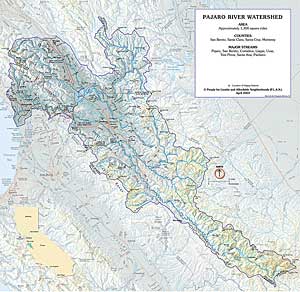
CLICK ON IMAGE FOR FULL SIZE
The Pajaro River watershed reaches from Monterey Bay to the Fresno County line.
Map: People for Livable and Affordable Neighborhoods (PLAN). Much like the effort required to turn around a supertanker, incremental work over the last seven years by the Sierra Club Pajaro River Watershed Committee has started to change views about the Pajaro River.
The latest contribution of the Committee is to set a vision before the community of how it can reconnect to the River. Recently the Watershed Committee raised money to hire a team of urban planners headed by Dr. Matt Kondolf, urban planner and hydrologist from U.C. Berkeley. Kondolf and his associate, Jennifer Natali have developed illustrations and plans for six sites along the lower Pajaro which would connect it to its communities. The Committee will take these maps and drawings to local organizations in order to inspire a new vision for this important local waterway.
Access points are sorely needed because downstream from Chittenden Gap there are few ways to get to the river despite the fact that people have the legal right to enjoy the river between the high water marks. Without access, the lower Pajaro no longer carries boaters or swimmers. Children and adults no longer line its banks to fish.
The River's slow decline
Years ago, Ohlone Indians living in the upper Pajaro River watershed paddled their tule rafts all the way to the river mouth, where they built bonfires and caught the grunion that came ashore. In the 1800s residents and tourists of the Pajaro Valley enjoyed carnivals and celebrations along the River as well as swimming, fishing and bathing.
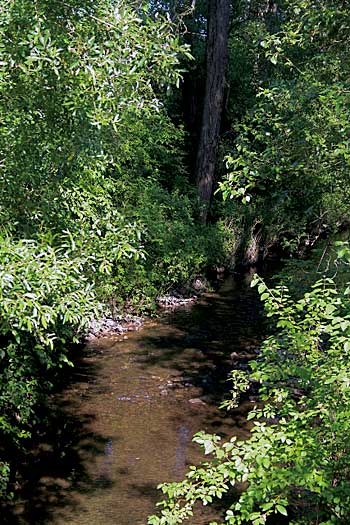
Corallitos Creek Photo: Lois Robin Slowly, towns were built on the flood plains. In 1850 farmers built dikes to restrain winter flows from flooding their fields. In 1949, the Army Corps of Engineers straightened the River and replaced the dikes with levees. Sand and gravel mining in the upper watershed in the last 50 years have contributed to aggravated flooding. The 1949 levees are no longer effective.
After a section of the levee failed in 1995, the town of Pajaro was flooded. There was a hue and cry from growers and Pajaro residents and businesses demanding that something be done. Angry growers insisted on better maintenance of the "flood control channel" as they preferred to call the river. The Counties of Santa Cruz and Monterey responded by cutting the riparian corridor, leaving only one tree every 75 feet. With the corridor denuded of trees except in the Coastal Zone where the Coastal Commission intervened, the rich colony of birds and other wildlife left.
Growers won a lawsuit against Santa Cruz and Monterey Counties, which had to pay the growers $60 million. This lawsuit revealed an inter-county and inter-agency coordination problem. Local legislators Henry Mello and Fred Keeley rose to the occasion and mustered the political will to create the four county Pajaro River Watershed Flood Protection Authority as a way to address the coordination gap.
Thinking has changed
After the flood, Representative Sam Farr was able to obtain reauthorization to rebuild the levees. But in the years since the Army Corps first began planning the project, river awareness and appreciation has changed partially due to the hard work of the Club's Pajaro River Watershed Committee which has attended countless public meetings, submitted testimony, and written letters.
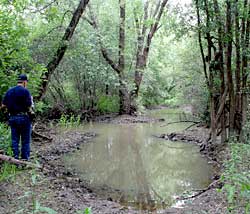
Photo: Lois Robin A 2003 art exhibit used the voices of the community, including its schoolchildren, to raise awareness of the value of the Pajaro River. A 2003 study of sediment problems in the River, underwritten by a grant obtained by the Committee, resulted in recommendations by Phil Williams and Associates to remove sediment and set back the levees in places to restore parts of the flood plain. This work will be done by the Corps and paid for by the State.
In 2005, the Committee released the video Stuck in the Mud: The Pajaro River in Peril which was shown on Community Television and widely distributed in Santa Cruz, Monterey, San Benito, and Santa Clara Counties. The next year, 2006, the Pajaro was named #1 Most Endangered River in America by the organization American Rivers in response to an application filed by the Committee.
Nationally, the tragedy of Hurricane Katrina helped precipitate a reexamination by the Corps of its mission and policies. A new Watershed Study by the Corps presages a more balanced approach to the levee project with the possibility of more habitat and environmental benefit.
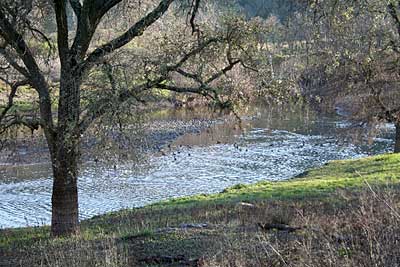
Llagas Creek Photo: Lois Robin Levee funding elusive
All of this planning is vital and precedes the levee flood protection project of the Army Corps of Engineers. Each year the Corps works on plans for the River, only to be halted by lack of funds. The Pajaro is low on the national list for funding despite lobbying by local Flood Protection Authority officials. Eventually the Corps will present design alternatives for public consideration. It remains to be seen how the Corps will resolve conflicting priorities.
The Pajaro River Watershed Committee does not hold regular meetings but is open to participation. For more information contact Lois Robin, 464-1184 or David Collier from the Loma Prieta Chapter, 408-847-3803.
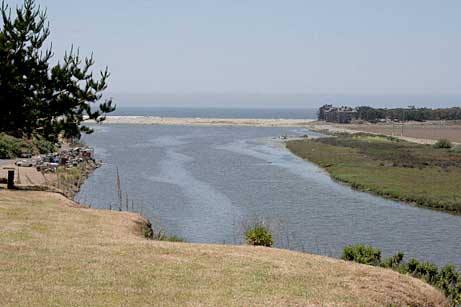
Pajaro River Mouth Photo: Lois Robin
|

